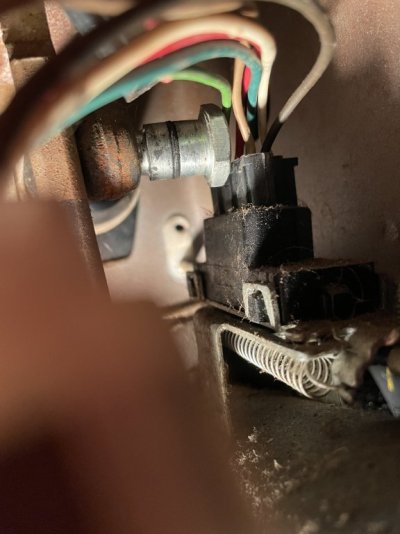The crankshaft pulley is a 4 groove balanced unit and after Evaporust & inspection it shows multiple pitting around on it. Mostly the 2 back A/C grooves. My question is will using it cause an unbalanced situation and excessive wear on the fan belts? Should I locate a better pulley? I also noticed a rubber damper on the backside, original engine color showing. Just an observation.
View attachment 583247
View attachment 583249
Will the pitting create an unbalanced condition? Of course. But not enough that I think the engine or you would ever notice it. It is close to the axis of rotation so has minimal effect.
I looked in my stash and I have 1 of these -757 pulleys but is rusted around ~180deg of it, as if it was sitting in dirt. IIRC it came off a '74 440 motorhome engine I got, and I've always suspected it sat outside for a while. I don't know if it's much better than yours. It also has a nick at 6:00.
I don't think the pitting will cause excessive belt wear, esp for how much most of us drive these cars vs when they were new.
As for the cam, my favorites for a street-driven C-body would be the Summit K6400 or 6401 and the Lunati Voodoo Series 60301, 630302, and 60303 (they got renumbered to xx701, 2, 3).
I'm not a big-time cam-swapper but I've done tons of reading of other folks testimonies and cut/paste that into a Word doc for wheat/chaffing.
The Summits are old grinds but get a lot of rave reviews on Moparts for working well and having good QC, I don't recall reading a single complaint on it. (IIRC it's an old Ultradyne grind but arrives in a Crane box?) FWIW - Summit notes these for 1968 and newer engines, presumably due to pushrod changes?
The Lunati Voodoos have tame lift & duration specs but faster opening rates so more area under the curve. I'm not sure I'd do the bigger 60303 in a 413 (it seems better for a 440), but your 4-speed would help use it.
For a mild 413 I think any of those would work well. The 60302 might seem a hair big for a 413, but I read a number of folks that used it in a 383 and were pleased.
Just pick bigger/smaller based on your own desires and the compression ratio you end up with. (I'd probably NOT use the 60303 in your case but wanted to mention it)
Other folks might suggest split-pattern cams or other stuff due to spec x, y, z -- and they might be right.
But I remember a sentiment a few guys said:
If you pick a good-match cam, vs what 'experts' might tell you to use instead, there won't be but a handful of HP difference between a good cam and the 'best' cam.
Lunati has these categories worth looking at:
The 60301:
Voodoo Hydraulic Flat Tappet - Chrysler 361-440 256/262
Hydraulic Flat Tappet. Best mild performance cam. Works excellent in fuel injection applications with performance chip. Makes approximately 19" vacuum at idle. Great for performance oriented marine applications and heavy towing applications. Perfect street rod cam. Has slightly noticeable idle, works with stock converter, A/C, power brakes and stock valve springs in most cases.; Advertised Duration (Int/Exh): 256/262; Duration @ .050 (Int/Exh): 213/220; Gross Valve Lift (Int/Exh): .454/.475; LSA/ICL: 112/108; Valve Lash (Int/Exh): Hyd/Hyd; RPM Range: 1000-5500; Includes: Cam Only
The 60302:
Voodoo Hydraulic Flat Tappet - Chrysler 361-440 262/268
Hydraulic Flat Tappet. Mid-level performance street cam with excellent drivability. Works well with stock type exhaust manifolds and dual plane intake with mild 4 bbl carb. This is an awesome 4x4 and performance marine cam where dry exhaust is used. Improved valve springs and roller rock- ers recommended.; Advertised Duration (Int/Exh): 262/268; Duration @ .050 (Int/Exh): 220/226; Gross Valve Lift (Int/Exh): .475/.494; LSA/ICL: 112/108; Valve Lash (Int/Exh): Hyd/Hyd; RPM Range: 1400-5800; Includes: Cam Only
The 60303:
Voodoo Hydraulic Flat Tappet - Chrysler 361-440 268/276
Hydraulic Flat Tappet. This high performance street cam likes 2400 RPM stall, 800 CFM carb, dual plane intake and headers. Makes un- equaled power to 6200 RPM with proper valve springs.; Advertised Duration (Int/Exh): 268/276; Duration @ .050 (Int/Exh): 226/234; Gross Valve Lift (Int/Exh): .494/.513; LSA/ICL: 110/106; Valve Lash (Int/Exh): Hyd/Hyd; RPM Range: 1800-6200; Includes: Cam Only
Summit Racing SUM-K6400 Summit Racing™ Classic Cam and Lifter Kits | Summit Racing
Summit Racing Part Number:
SUM-K6400
UPC:
190861126640
Cam Style:
Hydraulic flat tappet
Basic Operating RPM Range:
1,500-5,000
Camshaft Use:
Street/Strip
Camshaft Manufacturers Description:
Smooth idle, excellent low-midrange power. Works well with stock compression and stock stall.
Intake Duration at 050 inch Lift:
214
Exhaust Duration at 050 inch Lift:
224
Duration at 050 inch Lift:
214 int./224 exh.
Advertised Intake Duration:
288
Advertised Exhaust Duration:
298
Advertised Duration:
288 int./298 exh.
Intake Valve Lift with Factory Rocker Arm Ratio:
0.444 in.
Exhaust Valve Lift with Factory Rocker Arm Ratio:
0.466 in.
Valve Lift with Factory Rocker Arm Ratio:
0.444 int./0.466 exh.
Lobe Separation (degrees):
112
Camshaft Gear Attachment:
1-bolt
Computer-Controlled Compatible:
No
Lifters Included:
Yes
Summit Racing SUM-K6401 Summit Racing™ Classic Cam and Lifter Kits | Summit Racing
Summit Racing Part Number:
SUM-K6400
UPC:
190861126640
Cam Style:
Hydraulic flat tappet
Basic Operating RPM Range:
1,500-5,000
Camshaft Use:
Street/Strip
Camshaft Manufacturers Description:
Smooth idle, excellent low-midrange power. Works well with stock compression and stock stall.
Intake Duration at 050 inch Lift:
214
Exhaust Duration at 050 inch Lift:
224
Duration at 050 inch Lift:
214 int./224 exh.
Advertised Intake Duration:
288
Advertised Exhaust Duration:
298
Advertised Duration:
288 int./298 exh.
Intake Valve Lift with Factory Rocker Arm Ratio:
0.444 in.
Exhaust Valve Lift with Factory Rocker Arm Ratio:
0.466 in.
Valve Lift with Factory Rocker Arm Ratio:
0.444 int./0.466 exh.
Lobe Separation (degrees):
112
Camshaft Gear Attachment:
1-bolt
Computer-Controlled Compatible:
No
Lifters Included:
Yes

















